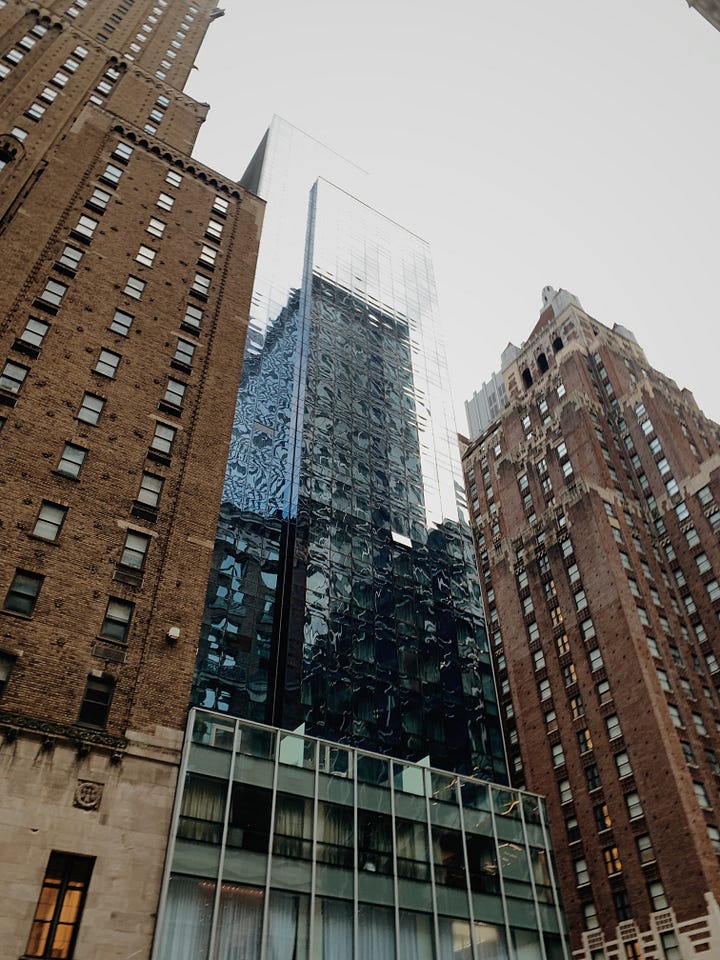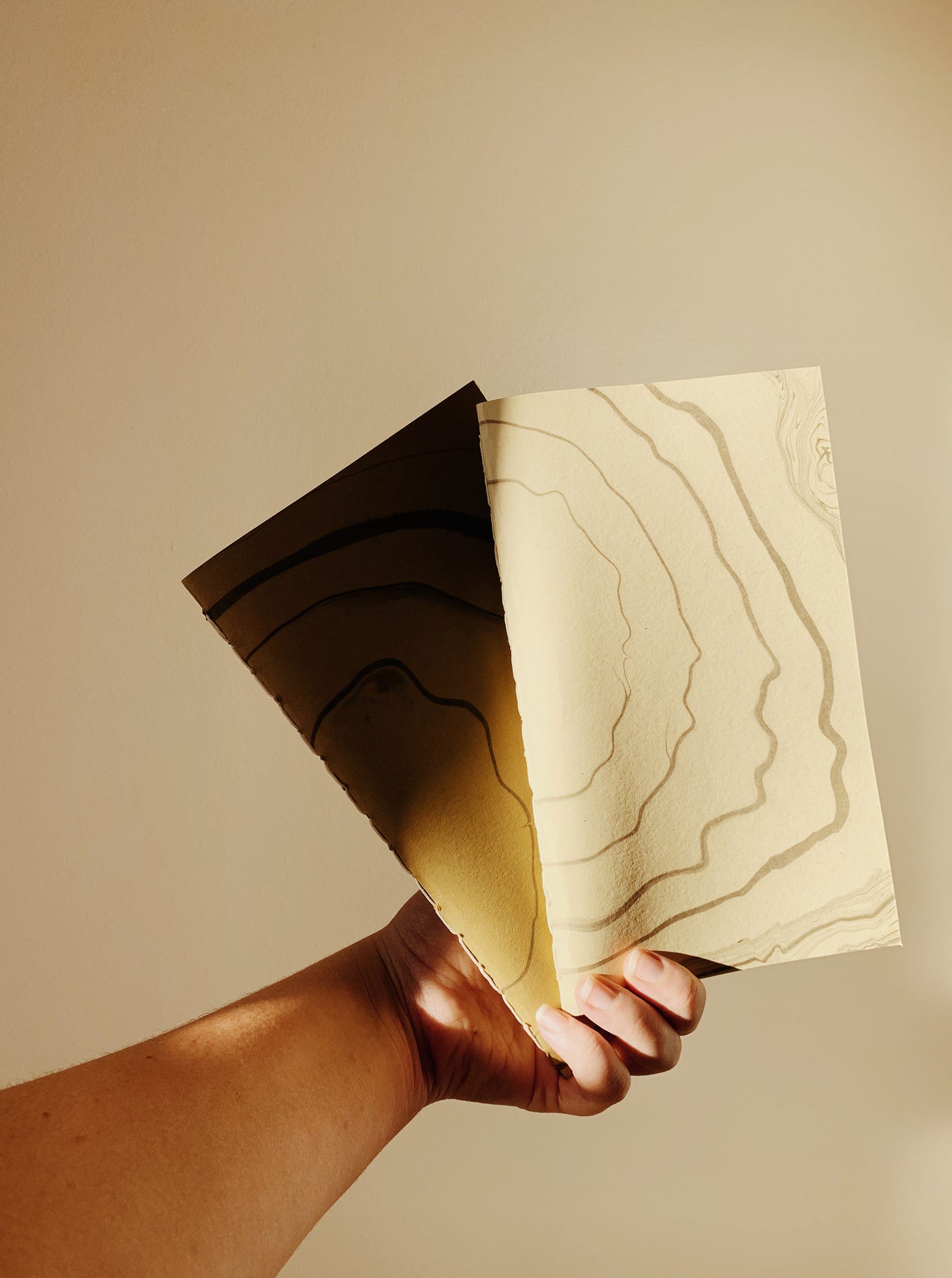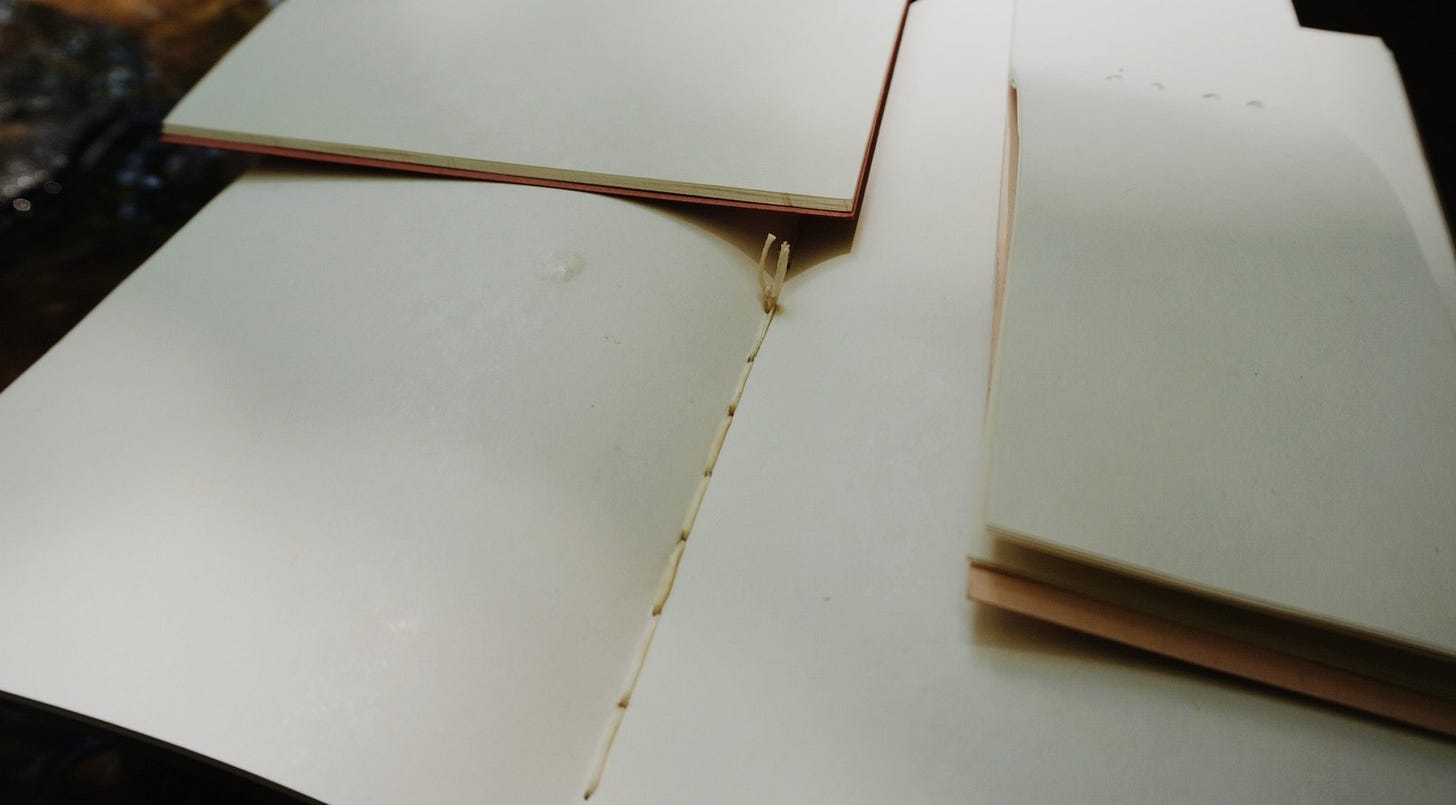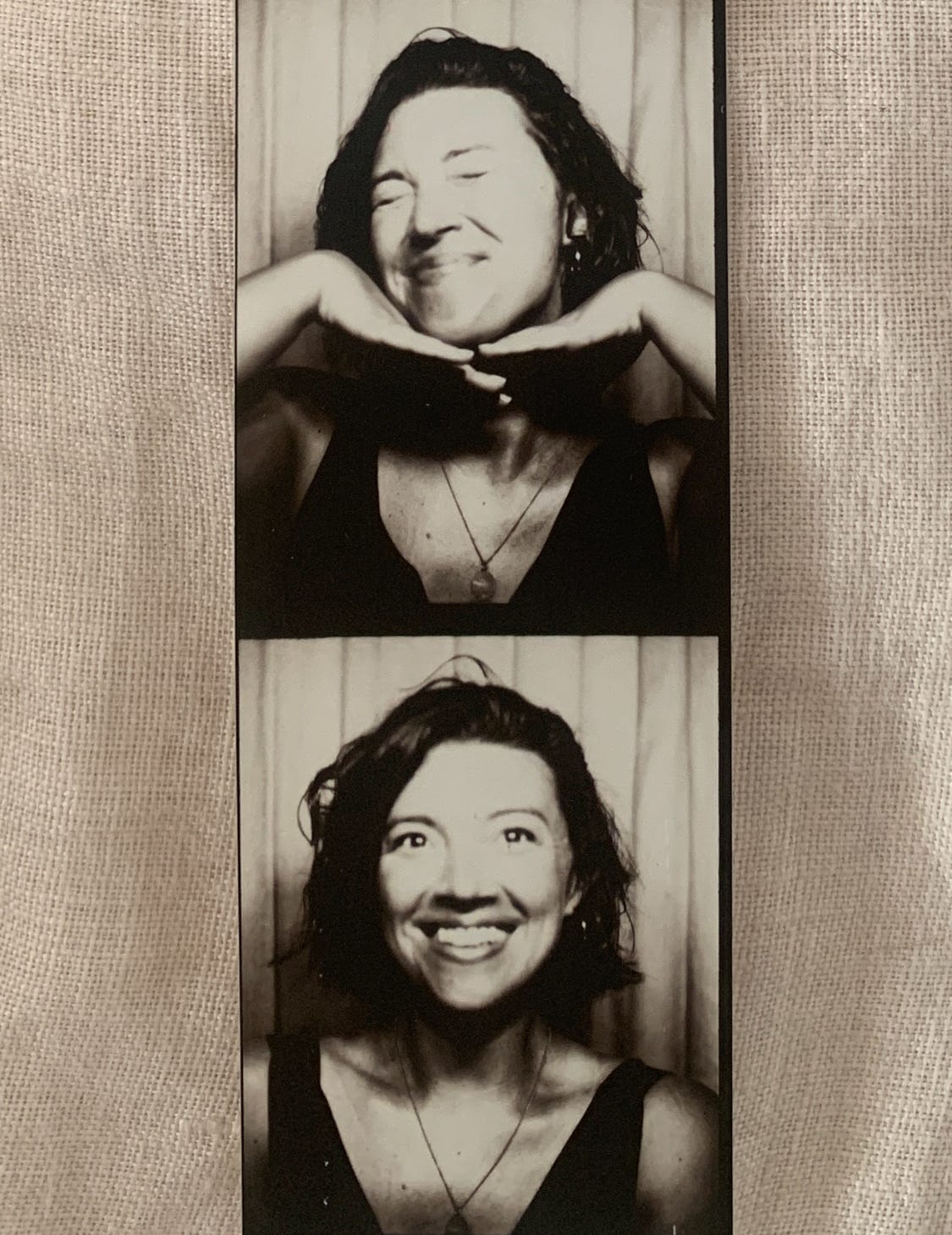Next week and the week after, find the corner of your creative practice. If you’ve been seeking some creativity or grounding the tactile or the texture and nature of paper, sign up. Next week’s workshops in Brooklyn center in on bookmaking, and I am slowly sharing classes for next month. I hope you’ll join in. Should you find a need or desire to start a creative, contemplative practice, and if you find resonance in focused conversation, my 1:1 sessions may be a good fit. As always, pair these practices with a journal or class recording. Find these both over at Odette Press.
In the corner of the kitchen, I stand transfixed. I am reading horizons as the day takes shape: morning, winter, silence, window. Snow is painted thin over nearby apartments, soft over the angles of rooftops. Winter, an immersion into the season: of slowness, of stillness, of writing and reading, the point of convergence.
I immerse myself in the corners of books so as to give myself an opening: a space to decompress and synthesize. Room for ideas, for inspiration, for departure. There, in the quiet corners of mornings, in the pages of writing and books, winter breathes, —slow and dormant. These mornings are corners of reverence for quiet and an inwardness. Book opens. Book closes. Lungs pulse slow. Eyes open and close and find center. Broad light turns to evening. Open to page, to the day, and idea. Meet yourself in your own corner, there at the center.
A corner is a convergence of two lines in conversation: two slopes of mountain, thought, page, meeting together. Books and writing exist at the intersection of writing and being: we think, feel, bring ourselves apart, craft an angle, then bring ourselves together. “If you are a writer, writing and being are the same thing,” Gail Sher writes.
To study a corner, I tune my view out toward perspective: the buildings across the street backed in blue sky, the body as it rises, lines of thinking as they come together and fall apart. I immerse myself in the fascination of shape. I hold. I unfold. I angle. I slope. I move. I sharp. I gaze. To tune in, I breathe wide into perspective. When I feel cornered, I bring my arms up, eyes wide and opening. The rhythm I whisper in the corner of myself in the act of reading and breathing? Opening, closing. Inhaling, exhaling.
In the stretch of subway between the city and my apartment is a favorite corner, seen from the West-facing side of the train car as the subway turns to face the skyline. Across the stretch of bridge, two boroughs meet, and in their meeting, bring in the wide view of perspective and awe. The beauty of the oncoming city is a view I anticipate. I am often open-eyed in anticipation and I angle toward it, forward, wowed, eager. The subway ebbs around the buildings, turning corners, a train car coaxed slowly onward. We bend, turn, and angle around until the view opens from closed buildings into wide view— and up ahead, in the distance, the city.


Over shorelines, around corners, the subways meet and overlap, intersecting each other. I emerge from my corners of mind enough to give myself space and time for noticing and being. A gentle moment. A breather. A break. I walk around, looking out at the sky. Cities are angular. Cities are often straight, harsh lines, heights often absent horizons, met sometimes with the sloping roam of shorelines. To soften the city, to rest between progress and stops, I open a book.
Reading is the meeting point of thinking and feeling, and pages are soft contrast to metal surroundings, and like train, I am pulled along, ripped through, careened between tunnels of thought and train, coaxed into and onward. The subway soothes and lurches, and I am soothed and lurched by writing, sometimes a line of text so resonant that I repeat it again and again until I have not only understood it, but felt it, to the point I submit to the moment and the environment drops away. Less stimuli, absent surrounding sounds, the whole subway disappears and drops away.
At the center point of writing and reading is a dialogue. A concentration. A meditation. A single-pointed focus. A conversation of ideas. The insistence of reflecting and reading. We are moved, soothed, aroused, annoyed, inspired, brought around by an idea, an image, a text, a page. We move ourselves toward words and stories, or away from them, based on story lines and lines of thinking, or aims, desires, or to give rest, or to find meaning. Writing and reading are two rivers joining, corners forming like the play between self and life and landscape; a way of pulsing, rhythm making. We dialogue in story and voice, in feeling and sensing, in the varying ways language is formed and reformed, bound and unbound, in the dimensions and interplay between mind and body, being and page.
“Words are sovereign,” Gail Sher writes, and they ask for an openness, a receptivity. “To open one’s mind, heart, and spirit one must be present to them — self-forgetfully immersed. You become an open book in order to read one properly.” Reading and writing are often many points joined together into single-points of being. “Books are solitudes in which we meet,” Solnit reminds. In writing and reading lines of thinking, living, and being cohere, converge, coalesce, and fade away. We open to them, we close them off, are cornered by them and between them, these books and ideas, and the spaces of our making. A book is a corner, and Bachelard, referring to Rilke, points out that a corner is an embodied space: a place converging, “a chamber of being”.
For a week I wonder about corners. I’m curious about the convergence, this creative force of ideas, embodied, resides. Corners of homes, wildness, cities, books, moments, feeling, pages. I investigate my own angles; I am bound in up in this. I turn. I angle. I play. I bring my arms behind me, opening body as book page. I open, I breathe, I close. I effort, I ease, I effort again. I bring one foot forward between two hands and lift my arms up toward the sky. Opening, I stand in the kitchen, chopping straight lines into apples and bundles of spinach, softening past sharpness into nourishment and insight. On the couch corner, curled up, containing soft angles, I sharp and soft. I angle. I write.
Corners, that I can tell, in my mornings curving along the river, do not exist in the currents of water. There are no harsh corners in water until winter comes and reminds of stillness, slowness, as coldness forms ice. Reading winter, I feel the lesson of finding my own still point and sharpness. But a confluence is the place where two streams of water meet, swirling into and toward each other. Ideas, streets, and arms eddy and estuary, conjoining, coalescing, and overlapping. They page. They turn. They dialogue. They overlap. They break apart and meet at the center.
Cohere. To stick together. To find yourself in idea, in awareness and environment again. Between the pages of writing and books you incline toward ideas and aims: the ways you are bound together and unbound, by idea, by desire, by disruption, departure, or by dedication, or bound by intention. Coming together, falling apart, through writing and reading we find ourselves in dialogue approaching center again. We fold ourselves and unfold. We contain language. We speak volumes.
The intimacy of meeting in two places, of two points meeting, creates a container. The slopes of two mountains forming a valley; pages intersect to make the folds of a book. A corner. Two vantage points are shown in paintings, or in two ideas meeting. Two arms open — wide, a heartbeat, a gesture of openness and outstretching, receiving. We meet book and idea and each other in varying stages of receptivity. “A book is a heart that only beats in the chest of another,” Solnit continues. A book has resonance, power, when you feel it.
A vertex, a turning point, a corner: the places of two lines coming together. Your parents met, and had you; two sides of stone push up from earth to form the places where mountains meet; your left meets your right, drawing you together in your center. Your reality mixes with mine and creates ours, and somewhere along the line of sight your view meets vantage points meet with ever-changing horizons. Two points of ideas meet and something is sparked. Your arms reach wide, and your heart is there, beating. What emerges? Convergence: the meeting of two points at an incline, or the ways in which we are inclined together. We become living volumes bound and unbound together.
The practice and dialogue between reading and writing is the home we create for ourselves. A dialogue of body and mind, opening and closing, these steady points of focus serve as ground, as a corner, as a chamber, a refuge to rest mind and body; a centering place. To be in our own corners is to develop a practice of relating to ourselves and our lives, arms up in the rhythm of opening, opening closing and widening, an angle outstretched. Writing is being with life and reading is an idea, receiving. To the corner, discovering the angle, turn the page. Immersing yourself in the heartbeat of thinking, the rhythm of being.
To be in your own corner, to be on your own side, to find center, is to accept all sides of you and meet yourself where the lines of you find coherence. You are the conduit, the centerline, the present tense, and there, at the relative center of you is the beat of your heart, your life being lived and reflected. To turn a corner, to flip the page to make progress, to bring one’s self together in your own space. We exact, measure, we slope, we round, we refine, we channel. We notice our confluence and sharp edges, and continue. How water, in time, and with persistence, softens broken glass, making smoothed lines of acute angles. You bring together concentration and ease, and meet yourself with hard edge and softness, each equal.
Opening your arms wide, you speak in dialogue with life. In reflection and receptivity. Action and resting. These are the two points of the corner. You find breath, voice, heartbeat. You center arms, voice, chest in the act of making. You learn to listen, to witness, to notice your own angle. To be in your own corner requires patience, steady, tenacity. You become your own reader in the language of your living.
Notice your two sides: left and right, front and back, and how you exist in multiple dimensions. Find vision in your mind, breath in your body, heart of your writing. Notice your spine, the lines you make, and how you are both sharp and shoreline. Take your arms out to the edges of the room and breathe. Expand your thinking, and feel the convergence of your arms outward from the center of your chest. There, trace yourself at the center. Embrace yourself. Feel the corners where you came from and where you come together. Notice coherence.
How are you in your own corner? What does your heartbeat say? Sense the space of body, idea, and mind. What are you opening to? What are you bound together with? What are you reading?
From the Studio:
Nourished by, Nourishing:
This week I’m running and reading and getting my calendars squared away. February classes arrive soon; sign up for classes. This week’s piece draws from inwardness of winter, and study, and practice. I’m playing with variations on vegetables, stews, and soups, and reading One Continuous Mistake: Four Nobles Truths for Writers by Gail Sher, The Wisdom of No Escape and the Path of Lovingkindness by Pema Chödrön, and The Faraway Nearby by Rebecca Solnit. All quotes pulled from today’s essay are from these texts; I’m grateful for time and dialogue with these pages and teachers.








